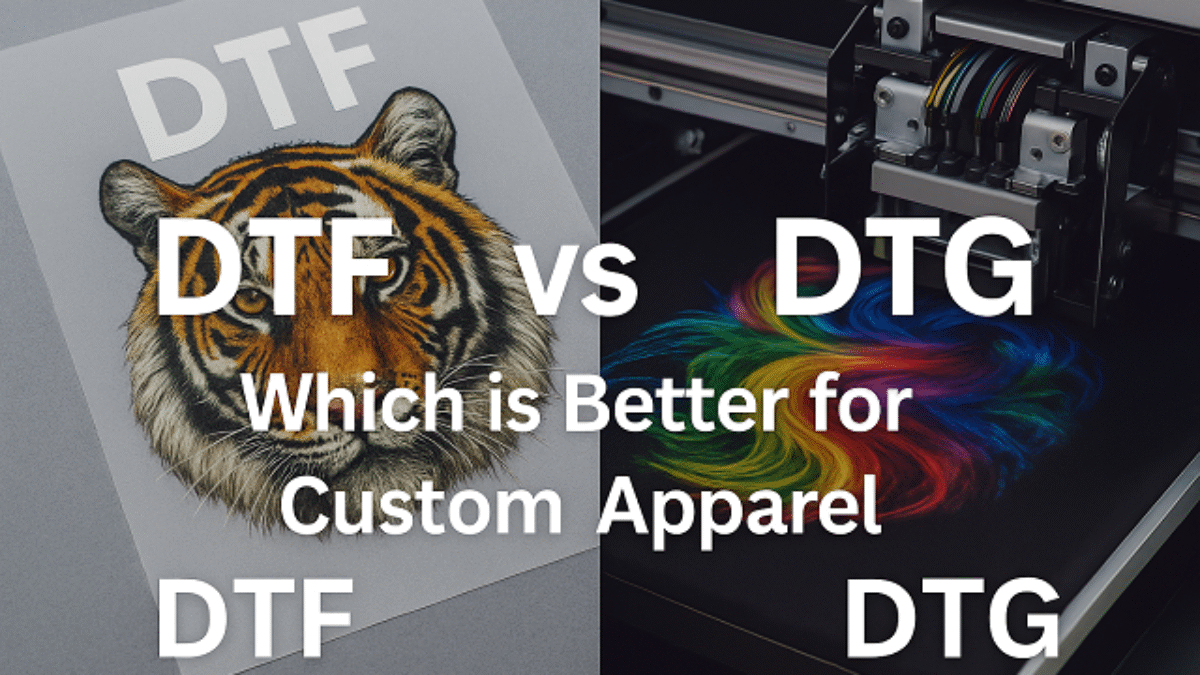Custom apparel is growing in popularity with businesses, brands, and individuals looking to stand out. Choosing the right printing method is crucial to ensure high-quality, long-lasting results. Two of the most widely used techniques are Direct to Film (DTF) and Direct to Garment (DTG) printing. This article compares DTF vs DTG printing in terms of quality, cost, durability, and versatility. By the end, you will know which method suits your needs best.
What is DTF Printing?
DTF (Direct to Film) printing is a modern method that transfers designs from film to fabric using heat and adhesive. You first print the design on a special PET film using DTF inks. Then, you apply a hot-melt powder adhesive on the printed design. Once cured, you heat press the film onto the fabric. The result is a vibrant and flexible print that works on many fabric types.
DTF printing does not require pre-treatment of the garment. It saves time and makes it ideal for high-volume orders. It also produces sharp details and bright colors. DTF works well on cotton, polyester, blends, and even dark fabrics.
What is DTG Printing?
DTG (Direct to Garment) printing is another popular method that uses inkjet technology to print designs directly onto garments. The design soaks into the fabric fibers, creating a soft and breathable finish. DTG requires pre-treatment to help the ink bond with the fabric. After printing, the garment undergoes heat curing to lock in the colors.
DTG printing excels in photo-realistic prints with gradients and fine details. However, it works best on 100% cotton or high-cotton blends. It is ideal for small orders and one-off designs due to minimal setup.
DTF vs DTG Printing: Print Quality
When comparing DTF vs DTG printing in print quality, both deliver impressive results. However, each method excels in different ways.
DTG produces smoother and softer prints because the ink integrates into the fabric. This results in a natural feel, especially on cotton. It is perfect for complex designs and full-color photographs.
DTF, on the other hand, creates bold and vibrant prints with sharp lines and rich colors. The film-based process enhances color accuracy and contrast. Though the prints feel slightly thicker, they remain flexible and durable.
DTF vs DTG Printing: Fabric Compatibility
Fabric type greatly impacts print quality and longevity. DTG printing performs best on cotton fabrics. If you print on polyester or blends, results may vary.
DTF printing works on a wide range of fabrics including cotton, polyester, nylon, blends, and more. This versatility gives DTF an edge, especially for mixed-material garments and accessories.
If your project involves varied materials, DTF printing is the better option. It gives consistent output across different textures and colors.
DTF vs DTG Printing: Durability and Washability
Durability is essential for custom apparel. Customers want prints that last through frequent washing and wear.
DTF prints are known for their strong adhesion and resistance to cracking, fading, or peeling. They remain bright even after many washes.
DTG prints are softer but may lose vibrancy over time, especially without proper washing care. Pre-treatment and curing play a key role in DTG print durability.
For rugged, long-lasting designs, DTF printing often outperforms DTG in overall lifespan.
DTF vs DTG Printing: Production Speed and Efficiency
DTG printing is ideal for small runs and quick turnarounds. The digital process allows you to print designs directly without extra steps. However, you must pre-treat garments and cure the ink.
DTF printing involves several steps but eliminates the need for pre-treatment. You can print transfers in bulk and press them later, increasing efficiency for large orders.
If you need speed for small batches, DTG is suitable. For high-volume production, DTF offers better scalability.
DTF vs DTG Printing: Cost Comparison
Cost is a deciding factor for many custom apparel businesses. DTG printers and inks are expensive, and the pre-treatment adds labor time.
DTF printing requires adhesive powder and PET films, but the equipment is often more affordable than DTG machines. It also reduces labor due to no pre-treatment.
For startups and small businesses, DTF printing provides a lower-cost entry point with less maintenance and greater flexibility.
DTF vs DTG Printing: Environmental Impact
Both DTF and DTG printing methods use water-based inks that are eco-friendly. However, DTG uses more water and energy for pre-treatment and curing.
DTF printing is cleaner and produces less waste. You can store unused DTF prints and use them later, reducing material waste.
Environmentally-conscious brands may prefer DTF for its efficient and low-impact process.
DTF vs DTG Printing: Best Use Cases
Let’s explore the best applications for each method.
Use DTG printing when:
- You need soft, breathable prints on cotton apparel.
- You offer on-demand printing for personalized gifts.
- You want high-resolution photo or gradient artwork.
Use DTF printing when:
- You want vibrant, durable prints without pre-treatment.
- You work with mixed fabrics and darker garments.
- You manage high-volume bulk orders.
DTF vs DTG Printing: Final Verdict
Choosing between DTF vs DTG printing depends on your project’s goals. Both methods offer professional-quality results with unique advantages.
If you value soft finishes and realistic images on cotton garments, DTG printing is a great fit. But if you want maximum fabric flexibility, bold colors, and high durability, DTF printing is the better choice.
Many businesses now use both methods to meet different client needs. Combining DTF and DTG printing expands your offerings and increases customer satisfaction.
Conclusion
DTF vs DTG printing is a common dilemma in the custom apparel world. While both have merits, your choice should depend on budget, fabric type, volume, and quality needs. DTF printing continues to rise in popularity due to its versatility and cost-effectiveness. DTG remains a reliable method for cotton garments and detailed photo prints.
Whichever method you choose, investing in the right technology ensures lasting success and happy customers. Explore both options, test samples, and deliver apparel that leaves a lasting impression.


Add a Comment
You must be logged in to post a comment